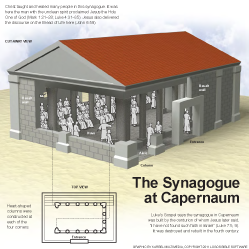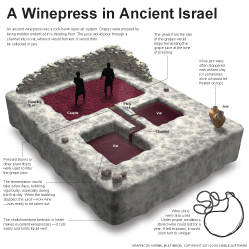9:1–8 Jesus continues to display His power, including His authority to forgive sins. The scribes (teachers of the law) begin to express discontent and accuse Jesus of blasphemy. |
9:1 his own town Refers to Capernaum, on the northern shore of the Sea of Galilee. See note on Luke 4:31.
on the northern shore of the Sea of Galilee. See note on Luke 4:31.
9:2 they brought to him a paralytic Parallel accounts appear in Mark 2:3–12 and Luke 5:18–26, both of which describe the man’s friends lowering him through the roof due to the large crowd.
child A term of endearment. Jesus exercises His authority with compassion.
your sins are forgiven People in ancient Israel commonly saw a relationship between sin and sickness (or suffering; e.g., John 9). Although Matthew does not explicitly state this connection, it could explain why Jesus begins by announcing forgiveness for the paralytic.
Jesus Heals a Paralytic | ||
9:3 scribes A legal expert or teacher of the law. See note on Matt 8:19.
See note on Matt 8:19.
said to themselves These individuals may be whispering together or thinking these thoughts individually. They do not publicly accuse Jesus here.
This man is blaspheming This is the first time in Matthew the religious leaders accuse Jesus of blasphemy (compare vv. 34; 12:24, 31–32). Their objection is that, in proclaiming forgiveness, Jesus is doing something that only God could do (compare Mark 2:7).
9:4 knowing their thoughts The Greek idiom used here seems to emphasize Jesus’ perceptive abilities—that He perceives the scribes’ (teachers of the law) negative reaction—not necessarily that He is reading their minds.
evil Refers to the scribes’ accusations of blasphemy.
9:5 which is easier Because there was no way to determine whether the man’s sins were forgiven, it was an easy claim to make (and dismiss). The command to rise and walk, however, was subject to immediate verification—putting the speaker’s credibility on the line.
9:6 Son of Man See Matt 8:20 and note.
authority on earth to forgive sins Jesus states that He is acting on God’s authority.
9:7 he got up and went to his home By showing His power to heal, Jesus demonstrates His authority to forgive. The healing also shows that Jesus truly is God’s representative.
 Miracles of Jesus Table
Miracles of Jesus Table
9:8 they were afraid Since they respond by praising God, their fear reflects reverential awe rather than terror and trembling (compare 14:30; 17:6; 27:54).
authority A central theme throughout Matthew, especially as Jesus’ authority is contrasted with established Jewish authorities such as the law, the temple, and the religious readers (e.g., 5:17–20; 7:29; 12:6; 21:23–27; 23:1–36). See 28:18 and note.
9:9–17 Jesus calls Matthew to be His disciple and responds to questions about the validity of His ministry. |
9:9 tax booth See 5:46 and note.
Matthew This Gospel is attributed to Matthew, who is called Levi in other Gospel accounts (Mark 2:14; Luke 5:27). It was not uncommon for first-century Jews to have more than one name.
he stood up and followed him Matthew immediately obeys and begins following Jesus. Luke mentions that Matthew (Levi) left everything (Luke 5:28).
9:10 as he was dining in the house Matthew likely held a reception on Jesus’ behalf and welcomed Him as a guest. Jesus eats at the home of Zacchaeus the tax collector in Luke 19:1–10.
many tax collectors and sinners These were probably Matthew’s friends and former colleagues.
9:11 Pharisees See note on Jn 1:24.
9:12 Those who are healthy Jesus’ answer might be a simple analogy. It also could reflect the cultural assumption that disease was associated with sin (compare Matt 8:16–17; 9:1–8).
9:13 go and learn A common formula used by rabbis to direct their followers toward a particular passage in the Scriptures. Jesus’ use of this formula might be a subtle jab at the Pharisees, who are not His disciples and represent the learned of Jewish society. Because they have failed to properly understand the spirit of the law, Jesus treats these experts as beginners.
I want mercy and not sacrifice Jesus is quoting Hos 6:6, which critiques Israel for focusing on the letter of the law while ignoring its spirit. God desires His people’s faithfulness and steadfast love more than their ritual observances.
the righteous Refers to people who are perceived as being righteous. According to Jesus, true righteousness involves showing mercy toward outcasts.
9:14 the disciples of John Refers to disciples of John the Baptist (Matt 3).
(Matt 3).
fast John’s disciples likely are referring to a voluntary practice of fasting twice a week as an act of religious piety (compare Luke 18:12).
9:15 when the bridegroom is taken away Alludes to Jesus’ crucifixion. The bridegroom in the metaphor is Jesus, and the guests are His disciples.
The bridegroom in the metaphor is Jesus, and the guests are His disciples.
9:16 unshrunken cloth Refers to new cloth that has not been washed or treated.
Parables of the Cloths and Wineskins | ||
9:17 new wine Unfermented wine.
wineskins Leather pouches used for storing wine.
9:18–26 Jesus has already displayed His authority over sickness, nature, evil spiritual powers, and sin; now He demonstrates authority over death. All three Synoptic Gospels (Matthew, Mark, Luke) report this episode, and all three interrupt it with the report of Jesus healing a woman (compare Mark 5:21–43; Luke 8:40–56). |
9:18 one of the rulers Mark and Luke identify this man as Jairus, a synagogue official (Mark 5:22; Luke 8:41).
a synagogue official (Mark 5:22; Luke 8:41).
she will live Demonstrates his faith in the miraculous power of Jesus.
9:20 suffering with a hemorrhage twelve years Depending on the nature of her ailment, the woman might have been ceremonially unclean during the entire 12-year span (see Lev 15:25–30). In this case, her condition was not only a physical problem, but a social and religious problem as well. Anyone who associated closely with her would have become unclean, too.
during the entire 12-year span (see Lev 15:25–30). In this case, her condition was not only a physical problem, but a social and religious problem as well. Anyone who associated closely with her would have become unclean, too.
9:21 If only I touch his cloak She believed that even Jesus’ clothes contained some of His miraculous powers.
9:22 daughter A term of endearment (compare Matt 9:2).
Your faith has healed you Jesus often cites a person’s faith as the impetus for healing (compare 8:13; 9:29; 15:28).
Jesus Heals a Bleeding Woman | ||
9:23 came into the ruler’s house The narrative shifts back to the situation of Matt 9:18–19.
the flute players and the disorderly crowd Participants in a funeral. Burial in first-century Palestine took place soon after death, so the presence of these mourners indicates that the process is already underway.
in first-century Palestine took place soon after death, so the presence of these mourners indicates that the process is already underway.
9:24 sleeping Jesus is not denying the fact of the girl’s condition as much as the finality of it. Sleep is a euphemism for death elsewhere in the Bible (e.g., Dan 12:2; John 11:11–12; Acts 7:60; 13:36; 1 Cor 15:6).
9:25 took her hand Touching a corpse rendered a person ceremonially unclean, but Jesus is not concerned with that (Num 19:11; compare Matt 8:3 and note).
got up The Greek verb used here, egeirō, is also used to describe Jesus’ resurrection (28:6–7).
Jesus Raises Jairus’ Daughter | ||
9:27–31 Jesus’ ministry of healing continues with two blind men receiving their sight. |
9:27 Son of David A messianic title meaning “descendant of King David” (see note on Matt 1:1; compare 12:23; 15:22; 20:30; 21:9, 15; 22:42).
meaning “descendant of King David” (see note on Matt 1:1; compare 12:23; 15:22; 20:30; 21:9, 15; 22:42).
9:28 the blind men approached him The men showed great faith and initiative.
9:29 According to your faith let it be done See v. 22 and note.
9:30 See that no one finds out Despite Jesus’ apparent desire to keep a low profile, His call for secrecy is not obeyed. Once these men experience the good news, they cannot keep it to themselves.
9:32–34 Jesus again asserts His authority over the spirit realm (compare 8:28–32) and causes all of Israel to marvel at His deeds. |
9:34 By the ruler of demons he expels the demons Jesus later shows the absurdity of this statement (see 12:22–32).
9:35–38 These final verses summarize Jesus’ ministry (compare 4:23). They also set up the next chapter, in which Jesus sends out His disciples. |
9:36 like sheep that did not have a shepherd Jesus’ compassion for the people was intensified by the lack of leadership to help them (compare John 10:1–18; Ezek 34). Without a shepherd, sheep are prone to wander and vulnerable to danger.
9:38 that he send out workers into his harvest Sets the stage for the events of Matt 10, as Jesus commissions His disciples to proclaim the good news of the kingdom of God.

|
About Faithlife Study BibleFaithlife Study Bible (FSB) is your guide to the ancient world of the Old and New Testaments, with study notes and articles that draw from a wide range of academic research. FSB helps you learn how to think about interpretation methods and issues so that you can gain a deeper understanding of the text. |
| Copyright |
Copyright 2012 Logos Bible Software. |
| Support Info | fsb |
 Loading…
Loading…



